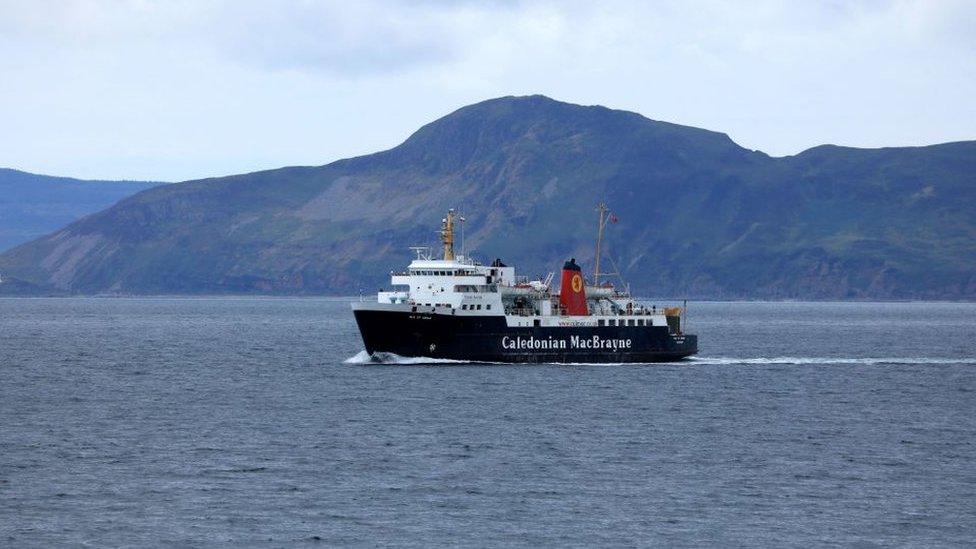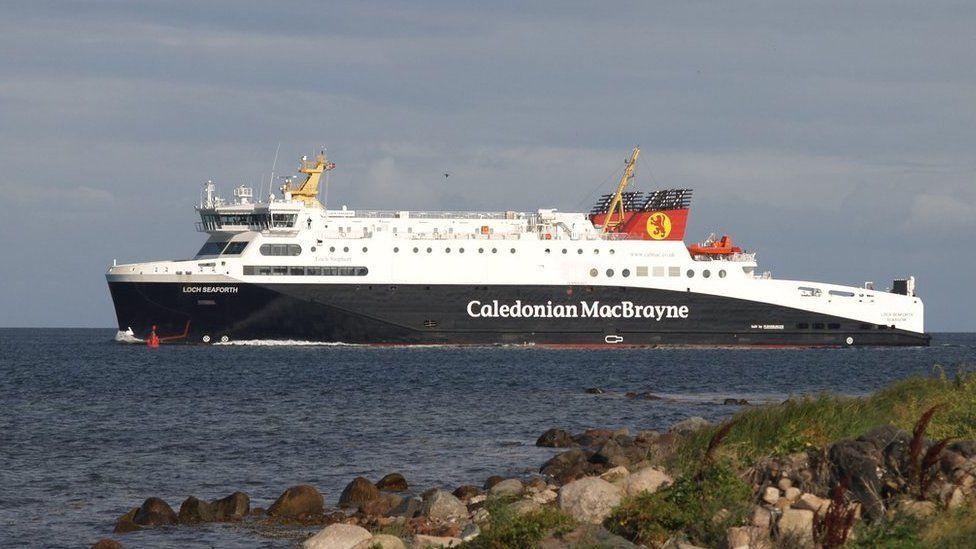Arran ferry woes costs island businesses thousands
- Published

CalMac has temporarily reduced sailings on its Ardrossan to Brodick route
Tourism businesses on Arran have said they are losing tens of thousands of pounds after one of two ferries serving the isle was diverted to another route.
The ferry is being used to support freight services between Stornoway and Ullapool following the breakdown of that route's Loch Seaforth last month.
Holiday accommodation providers on Arran said the move had led to booking cancellations.
Ferry operator CalMac said it was endeavouring to maintain services.
The Loch Seaforth - the largest and fastest ship in CalMac's fleet - had to be removed from its route between Stornoway on Lewis and Ullapool in the Highlands because of an engine problem.
It has been undergoing repairs at a yard in Greenock and the work is not expected to be finished until 17 May at the earliest.
CalMac has had to move ferries from other routes to help maintain services to the Western Isles.
This has included using one of Arran's two regular summer season vessels, leading to a temporary reduction in sailings between Ardrossan in North Ayrshire and Brodick on Arran.
CalMac said it had made extra provision available at the north end of Arran between Lochranza and Claonaig on the Kintyre peninsula in Argyll and Bute.
But Arran businesses bosses said accessing those sailings involved longer journey times, and would not suit visitors planning short stays on the island.
'Aging fleet'
Sheila Gilmore, of Visit Arran, said a survey of island businesses found five had suffered £80,000-worth of cancellations in the space of three days.
She told BBC Radio Scotland's Drivetime: with John Beattie programme: "That will give you an indication of the impact, and this is now happening until 17 May."
Robbie Crawford, of the Kinloch Hotel, said his business had lost out on about £30,000 due to cancelled bookings.
He told BBC Good Morning Scotland: "The whole island has really been quite badly affected. There's a lot of frustration here."
Mr Crawford praised the efforts of CalMac's workers and said the problem was the company's "aging fleet" and lack of spare capacity to deal with breakdowns.
Two new ferries - including one for the Arran route - are currently being built at the Ferguson shipyard in Port Glasgow.
Their initial completion date was set for 2018 but the work has seen repeated delays and overspending.

The MV Loch Seaforth serves CalMac's Ullapool to Stornoway route
CalMac said repairs to the Loch Seaforth were "progressing to plan".
Managing director Robbie Drummond apologised for the disruption to sailings.
He said: "We are working closely with local businesses to make sure that demand for travel is being met, and I am most grateful to them for their support, patience and understanding as we deal with this situation.
"We are confident that the MV Loch Seaforth will be back in service in a matter of weeks and the normal summer timetable will be back up and running as planned."

The big challenge for CalMac at present is its ships.
That may seem an odd comment to make about a ferry operator. But there some fundamental problems which make dealing with disruption hard.
Some vessels can only be used on particular routes - for instance because they may be unsuitable for particular harbours.
It means that if one ferry breaks down, another route may lose out while it is repaired.
It has led some islanders to wonder if, in the longer term, big ferries with large crews are really needed for relatively short runs like the sailings to Arran and Mull.
The argument is that a bigger fleet of smaller boats could provide a more flexible timetable with great benefits for islanders. If one vessel was out of action, it may not have such significant consequences.
The Arran Ferry Action Group is keen to explore this option.
Changes like these would however be controversial and take a very long time to implement - they are not a solution to the immediate problems.
But there is a counter-argument.
Sailings on a large ferry with catering facilities can be a treat for visitors and occasional travellers. They might help make islands attractive destinations.
Indeed the ferry currently withdrawn from the route - the MV Isle of Arran - was a victim of its own success. It came into service in the mid-1980s and proved too small to cope with the route's growing popularity. So a larger vessel is now the principal ferry on the service.
- Published23 April 2021

- Published22 April 2021

- Published15 April 2021
